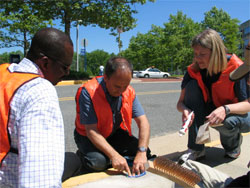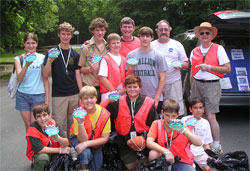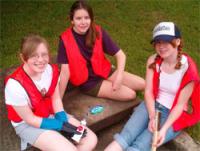Storm Drains and the Chesapeake Bay 
Storm drain labeling is an effective, low-cost method of educating residents about water quality problems in our streams, lakes, rivers and the Bay. NVSWCD is currently recruiting volunteers to lead storm drain labeling projects.
Storm drains are located throughout the Potomac River and Chesapeake Bay watersheds. What we do in our yards and communities affects the Bay through the storm drainage system.
When it rains, the water running along the gutters in the street vanishes down storm drains. Where does the water go? The water in a storm drain does not go to a treatment plant. This runoff drains directly into a local stream. All our local streams in Fairfax County feed into the Potomac River, which empties into the Chesapeake Bay. Nothing is removed from the water. That means pet waste, yard debris, fertilizer, motor oil, pesticides and trash all have the potential to flow into our streams and the Chesapeake Bay.
Pollution that enters our water resources through the storm drains is called non-point source pollution because it comes from all our homes and communities - many diffuse sources, not a single "point" source. Non-point source pollution is the leading cause of water quality deterioration in the Chesapeake Bay.
How Can I Help?
Volunteering to lead a storm drain labeling project is a fun way to give back to the community and help protect our natural world. Each project focuses on a neighborhood, informing people who live there about the dangers of dumping anything into a storm drain. Project leaders also emphazise that there are many things we can all do to prevent non-point source pollution.
Volunteers provide the legwork needed to educate residents and label the storm drains; NVSWCD provides all the supplies and materials. Groups that may wish to participate include homeowner and civic associations, scout and youth groups, school groups or conservation/environmental groups. Individuals and families are also welcome to volunteer. Volunteers start out by meeting with a staff member for a project orientation, and proceed to:
- Organize the project, including obtaining the approval of the local homeowner's or civic association and recruiting additional volunteers.
- Educate the community about non-point source pollution. Project leaders can write an article for a community newsletter and/or place fliers on doors of homes in the project vicinity to explain the connnection between storm drains and our streams.
- Label the storm drains with a "No Dumping" message. Groups will use pre-printed plastic markers and adhesive to label the storm drains.
NVSWCD will help you every step of the way!
- Read the step-by-step guide to storm drain education projects.
- Apply to lead a storm drain labeling project through the Fairfax County Volunteer Management System. Please note, although the opportunity indicates that there are "no shifts available", this is because this volunteer opportunity is completed at your own pace - there are numerous opportunities for labeling available!
- Share information about this volunteer opportunity with others: Download a promotional flier.



The Fairfax County Storm Drain Education Program is a joint venture of Fairfax County, the Virginia Department of Transportation - Northern Virginia District and NVSWCD.
Interested in cleaning up your local streams? Although our ultimate goal is to stop pollution from entering streams, we understand that it is also important to remove litter and debris from polluted streams regularly. You can learn about litter campaigns and sign up to lead or join a stream cleanup in Fairfax County with the Clean Fairfax Council.
Learn more about Illicit Discharges and Improper Disposals. Visit the Fairfax County IDID program to learn more about how to recognize and report IDIDs.

